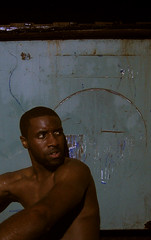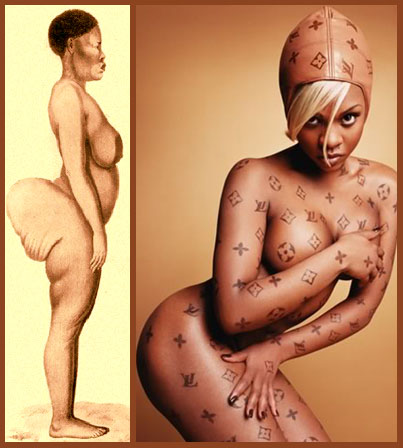lil kim: colonized and consumed
so, i can't look at that picture without seeing Saartjie_Baartman aka "Hottentot Venus". i can't shake it. with each glance, i see the disarming contortions of kim's diminutive form as a (failed) approximation of the curves and the boldness of her similarly exploited ancestor.
but there is a marked difference between the two images: kim is emphatically marked by the colonial project. her body is literally branded by/for french designer louis vuitton, a name that (given my urban, working-class orientation) has long been synonymous with the concept of invidious consumption. branding has a history that mustn't be ignored as we attempt to make sense of this photograph.
[The origin of branding may lie in the] literally dehumanizing treatment of a slave as mere livestock: just a biological entity owned and sold for arbitrary use and abuse (as agricultural work unit, house slave or toy). [Branding] was practiced by the European slavers as well as by African slave catchers. To a slaveowner it would be logical to mark his property on two legs just like cattle, or even more since humans are more adroit at escaping.
due to the function of branding as means of a punishment or imposing masterly rights over a legally subservient inferior, there is some question as to who owns the body that we see here.
the absenting of kim's clothes effectively blurs the lines between model and product in ways that beg the question: what (or who) does this advertisement ask us to consume? what objects (and/or bodies) are for sale and who is eligible to sell them? how do the elements of this photograph teach us to assign value to the (black female) body?
note how the blonde swoop threatens to obstruct her vision. it appears to be so tenuously situated that kim must remain perfectly still if it is to remain intact. an errant blonde lock hushes her pursed lips. they, too, must remain still as not to interrupt or soil our optical feast upon her nude body. for this moment, frozen in time by the snapshot, her vision -- her ability to see the world -- is decided and mitigated by where her blondeness happens to fall.
blondeness, then, catalyzes (or, at the very least, carries with it the possibility of) a temporary blindness of sorts. it goes beyond literally covering up black roots and actually obstructs the clarity of vision. this obstruction might be read as this black female subject's (willful?) subjugation to a vulnerable (disempowered?) position. this subjugation is an uncanny one though: it is enacted for pay and for a visibility that will result in more pay (in the form of album sales). the question: is there an element of volition present for kim that saartjie did not enjoy?
 with her black nude airbrushed body, kim invites us to join her and to do away with the pretense of clothing... we too can forego such trifling formalities and mark our very flesh with the sovereignty of her french colonizer.
with her black nude airbrushed body, kim invites us to join her and to do away with the pretense of clothing... we too can forego such trifling formalities and mark our very flesh with the sovereignty of her french colonizer. oh, i know... you want me (a self-avowed black feminist) to read some agency on kim's part. after all, her gaze meets the [white normative] gaze of the photographer/viewer, intense and unsmiling. uninviting, even. she decides how much of her body will be seen.
yeah, but homegirl is already marked... and that means homegirl laid down and allowed herself to be printed upon. once the inscription is made, i contend, agency is circumscribed in significant(perhaps irrevocable) ways.
and if i've learned anything in my time here at princeton, it's that the white supremacist project is quite willing to make some concessions if it means furthering its long-term interests. that is to say that sometimes white supremacy will allow you to act out (i.e. be black, bold, militant, agentic and even sexy) if you only agree to hand over your body to be marked by its primacy. if only you agree to occasional/temporary silencing.
and where are my girl's ears? tucked conveniently under that flesh-toned helmet, that's where. yet another sense forfeited.
 visible, but nearly blinded.
visible, but nearly blinded.inaudible and unhearing.
sexualized but circumscribed.
limbs forced to do the work of shielding her genitals from view when the colonial (LV) emblems fail to offer any protection.
this body is conquered terrain.
but that's just my reading...
i'm open to hearing yours.





7 Comments:
This is great work. Really quintessential LL analysis. I'd be interested in how you circle back around to your own use of your image(s) on the blog. No I'm not trying to rehash (redundunt wording as hash, as in corn beef hash oftentimes starts out as a re-ing of leftovers) old stuff but rather acknowledge how the old is made new in this moment given your analysis of Kim.
And what of Janet? Do we see the management of appropriateness in Janet, Kim, and Venus? When/how the (African) breast can be appropriately/appropriatingly bear?
And what of Kim's alleged cosmetic/cosmic/cosmologic surgeries? Has Kim already shown up to the photo shoot colonized in a sense from the inside out and now lay bear her colonization for the camera (pun intended)?
I'd love to hear your analysis of The Parkers.
Reg.
I've always been fascinated, and at the same time disturbed, by this particular LaChapelle portrait.
I didn't tally the numbers, but if a picture is worth a thousand words, then you captured what the camera lens saw. Well done, man. Well done.
"and if i've learned anything in my time here at princeton, it's that the white supremacist project is quite willing to make some concessions if it means furthering its long-term interests."
YES!
How refreshing to hear this!
The "white supremacist" is a master negotiator...
Attempts to decipher and discuss images like this and people like Kim are often cut short with comments like "its not that serious", "whatever" and the crowd favorite "she's just 'doing her'".
So I just settle for "she's a mess" and leave it up to you, Larry. I will just use this for reference as ususal.
Columbia University's Program for the Study of Sexuality, Gender, Health, and Human Rights presents:
“A simple African woman?”
The legacy of The Hottentot Venus
in contemporary South African politics of gender equality,
health and human rights
Rachel Holmes, PhD
Coordinator, Friends of the Treatment Action Campaign, UK
Wednesday, January 31, 2007 7:15-9:00 pm
Faculty House, Morningside Campus
Saartjie Baartman, known as The Hottentot Venus, is modern South Africa’s most revered female historical icon. A Khoisan peasant born at the end of the eighteenth century, her journey from slavery to controversial celebrity made her one of South Africa’s most famous daughters. In conjunction with the liberation from apartheid in 1994, Saartjie quickly became a potent symbol for political and cultural restitution. In response to an international campaign championed by Nelson Mandela, her remains were repatriated in 2002. After nearly two hundred years, her coffin returned to a hero’s welcome. Addressing so many live issues, Saartjie quickly became representative figure in South Africa’s struggle for gender equality.
Based on her original research, Rachel Holmes’s talk revisits Saarjtie’s story and examines how and why this young woman who became an international symbol of colonial and imperial excesses and the legacy of ‘scientific’ racism has played such an important role in the forging of post-apartheid national consciousness and human rights discourse.
Holmes shows how Saartjie Baartman is an iconic, living ancestor central to current women’s social justice campaigns on the issues of sexuality, gender based violence and rights violations against women with HIV and AIDS, and public health provision. The talk also explains and explores the implications of President Thabo Mbeki’s use of Saartjie’s history as a central example in his intellectual defence of his controversial HIV/AIDS denialism.
Directions to Faculty House: from 116th St. subway stop at Broadway, walk across main campus on College Walk (going east), cross Amsterdam Avenue, and continue walking along 116th St. Take the first left past Greene Hall (Columbia School of Law), walk through gates, and take the first right after Wein Hall. Faculty House is on the right, just before the gates. For map, see http://www.columbia.edu/cu/fachouse/
For more info, contact 917 498 2335
Thanks for posting this, great work!
Post a Comment
<< Home